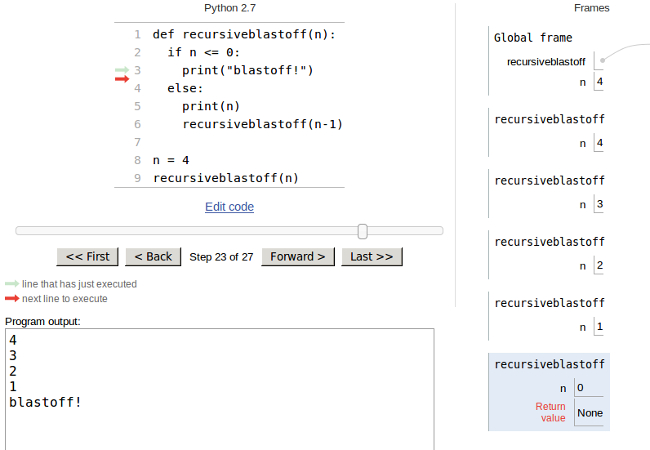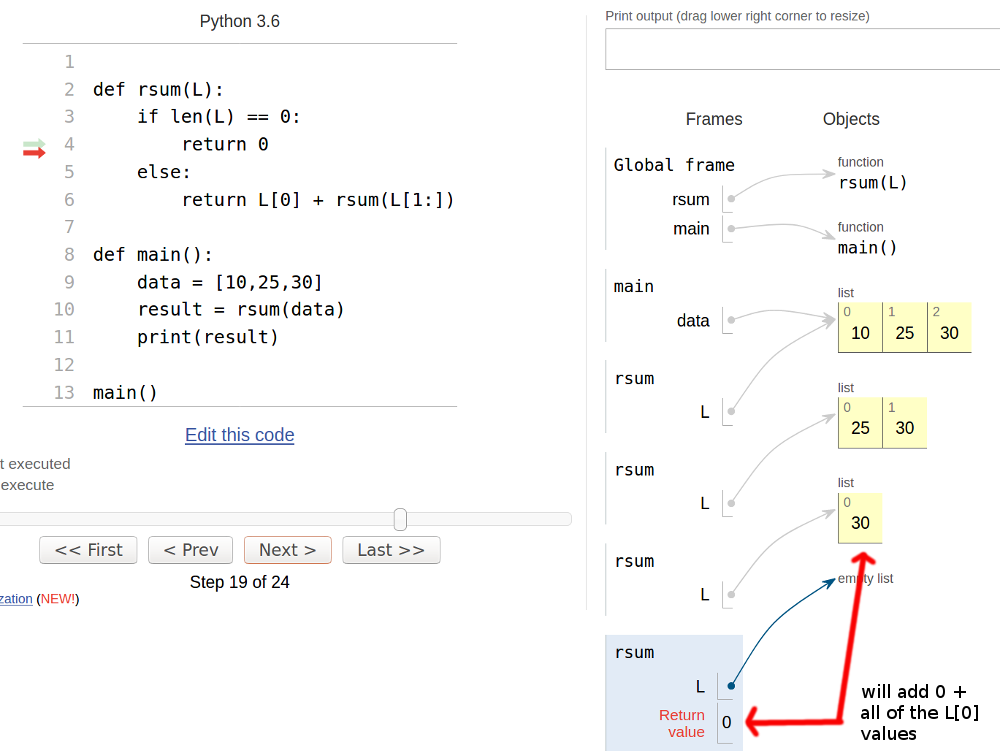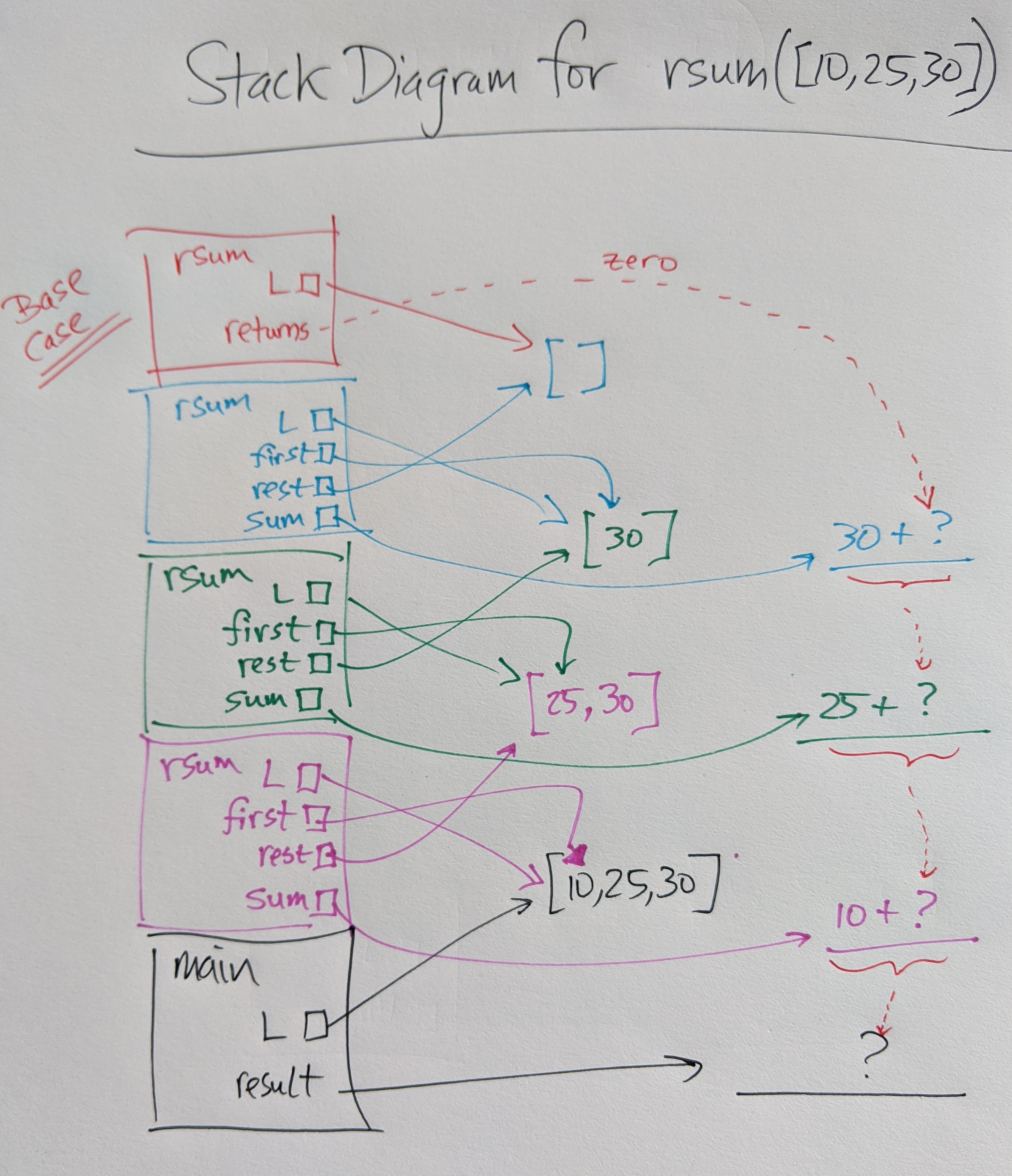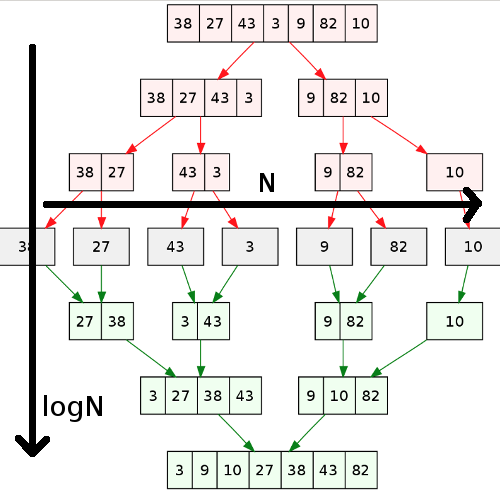Week 11: r e c u r s i o n
Monday
The video from today’s lecture (Monday, April 13, 2020):
And here are the annoucements:
-
Lab 9 is up and due Saturday (Apr 18)
-
Sent out lab 7 grades and midterm grade email
-
Still grading labs 6,8 and quiz 4
Recursion
Any function that sometimes calls itself is known as a recursive function. In most cases, recursion can be considered an alternative to iteration (loops). Instead of defining a loop structure, recursion defines a problem as a smaller problem until it reaches an end point. There are three requirements for a successful recursive function:
-
Base case: each function must have one or more base cases where the function does not make a recursive call to itself. Instead, the problem has reached its smallest point, and we can begin returning back the small solutions.
-
Recursive case: the function makes one (or more) calls to itself. The call must use a different argument to the function (or else we keep making the same recursive call over and over again!). Typically, the problem gets 1 smaller.
-
All possible recursive calls must be guaranteed to hit a base case. If you miss one, your program is susceptible to an infinite recursion bug!
Example: blastoff!
Here is the simple blastoff(n) function, to show a countdown from some number n, using a for loop:
def blastoff(n):
for i in range(n,0,-1):
print(i)
print("blastoff!")
Thinking recursively, you may notice that blastoff(10) is really just this:
print(10) blastoff(9)
And blastoff(9) is this:
print(9) blastoff(8)
And so on. The key to writing an algorithm recursively: handle the first item or case, then
let recursion handle the rest. For the above, given an integer n, we would:
print(n) # take care of n blastoff(n-1) # let recursion handle the rest
Also note, each subsequent call to blastoff() has a smaller value of n.
Eventually we will call blastoff(2), then blastoff(1), and then, finally, blastoff(0).
At that point, we want to just print "blastoff" and stop the recursion. This is formally
called the base case, and is usually written with an if/else clause.
Here is the full recursive blastoff function:
def recursiveblastoff(n):
if n <= 0:
print("blastoff!")
else:
print(n)
recursiveblastoff(n-1)Notice the base case stops the recursion (does not call another copy).
Also notice the non-base case (the else clause) heads toward the base case
by calling another copy, but with n-1 as the argument.
Sometimes, to understand recursion, it helps to think about the stack frames.
If the above function were called with n=4, how many frames would be put
on the stack? Try it in the python tutor!
Here is a screenshot of the stack frames,
when the recursion has reached the base case:

Tips for Recursion
For any recursive problem, think of these questions:
-
What is the base case? In what instances is the problem small enough that we can solve the problem directly? Sometimes you may need more than one base case, but rarely do you need several.
-
What is the recursive call? Make one or calls in the function to itself. It is very important to use different arguments (usually "smaller") in the recursive call otherwise you obtain infinite recursion.
-
Do all possible chains of recursion lead to a base case?
-
If a recursive function is supposed to return a value, make sure all cases return a value and that recursive calls do something with the return value of the smaller problem before returning.
Example: coin flips
Suppose we want to flip n coins and show how many turned up "heads".
Here’s the iterative function for that (assuming we have imported the
choice(..) function from random:
def flip(n):
"""flip n coins, return number of heads"""
count = 0
for i in range(n):
flip = choice(["heads","tails"])
if flip == "heads":
count = count + 1
return countFor the recursive version, how can we just flip 1 coin, and then let
the recursive function handle the other n-1 flips? The key is trusting
that recursiveflip(n-1) will give back the correct answer!
So recursiveflip(5) is the same as flipping 1 coin and then adding how
many "heads" we get from recursiveflip(4).
And what’s the base case? If each recursive call has one less flip to
do, eventually we will get to recursiveflip(0), and that should return
0 (the number of "heads" resulting from flipping 0 coins).
def recursiveflip(n):
"""flip n coins using recursion, return number of heads flipped"""
if n <= 0:
return 0
else:
flip = choice(["heads","tails"])
if flip == "heads":
count = 1
else:
count = 0
return count + recursiveflip(n-1)Example: in list
How about inlist(x,L), which returns True if x is found in the
list L, and False if not?
Slicing reminder
Before we write inlist(x,L), let’s review slicing in python.
Slicing lets you easily look at subsets of strings or lists. The
general syntax is S[i:j]. This gives the substring of S starting at
index i and running up to but not including index j.
$ python3 >>> hw = "hello world" >>> hw[1] 'e' >>> hw[7:10] 'orl' >>> hw[0:5] 'hello' >>> hw[6:] 'world' >>> hw[:5] 'hello'
You can also omit i or j. S[i:] gives you the substring starting at index i
and running to the end of that string. S[:j] gives you the substring up to
but not including the j-th character.
Note: slicing can also be used with lists e.g. if L = [1,2,3,4,5],
then L[2:4] is [3,4].
Now back to the inlist(x,L) example:
x = 5 L = [1,6,5,9,7]
How can we handle just one part of looking for x in L?
Let’s just examine the L[0] item, then let the recursion look
for x in L[1:] (the rest of the list).
And what’s the base case? If each time we recur with a smaller and
smaller list, eventually we will have and empty list ([]).
def inlist(x,L):
"""return True if x in L, False if not"""
if len(L) == 0:
return False # base case, nothing left in list, so x not found
else:
if x == L[0]:
return True # found x, no need to recur
else:
result = inlist(x,L[1:]) # keep looking
return result # return whatever we findWednesday
The video from today’s lecture (Wed, April 15, 2020):
Lots of small practice problems today!
Here’s what we worked on in the breakout rooms:
-
recursive sum of a list
-
recursive count how many of x are in list L
-
recursive reverse a string
sum a list
For this one, how can we do just one small part of the summation?
If we have a function (nevermind that we are currently writing it!)
called rsum(L) that returns the sum of a list, then recursively,
the sum of L can be written as L[0] + rsum(L[1:]) (first item plus
sum of the rest of the items).
This means we will be recurring on smaller and smaller lists, which leads us to the base case: what should this function return when the list is empty? What it the sum of an empty list?
Here’s one way to write rsum(L):
def rsum(L):
"""use recursion to sum a list"""
if len(L) == 0:
return 0
else:
return L[0] + rsum(L[1:])Many students see that and ask, isn’t the final return 0 being
sent back to main? Here’s the stack diagram for the recursive sum
function:

The base case stack frame returns 0 to the previous call
of rsum, which returns it’s L[0] plus the base case’s 0
to the rsum call before that, which returns it’s L[0]
and so on…
count x in L
We’re looking to count how many of x are in L. Again, how can
we do just the first part (i.e., count the first item), then let
recursion handle the rest?
If we were doing an accumulator, we would do something like this:
count = 0
if x == L[0]:
count = count + 1Letting recursion count the rest means again sending the rest of
the list (L[1:]) to another copy of the function. Since the list
is getting smaller and smaller with each recursive call, the base
case is "how many of x are in an empty list?".
def rcount(x,L):
"""use recursion to count how many of x are in L"""
if len(L) == 0:
return 0
else:
count = 0
if x == L[0]:
count = count + 1
return count + rcount(x,L[1:])Friday
The video from today’s lecture (Friday, April 17, 2020):
And here are the annoucements:
-
Finished grading quiz 4, quiz 5 will be next week
-
Quiz 5 is on files, searching, and sorting
-
Ninja session tonight, office hours today
-
Still grading lab 8
go over quiz 4 files
Ask me if you still don’t understand any of the questions from Quiz 4!
recursive stack example
See stackexample.py….draw stack for rsum(L) function.

merge sort
Edit sorts.py, add mergeSort(L) function.
def mergeSort(L):
"""sort list using merge sort"""
if len(L) > 1:
# split into two lists
half = len(L)//2
L1 = L[:half]
L2 = L[half:]
# sort each list
mergeSort(L1)
mergeSort(L2)
# merge them back together
merge(L1,L2,L)Run timing.py to compare merge vs selection sort.
Merge sort is an O(NlogN) sort!
